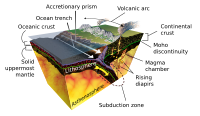
Photo from wikipedia
A primary goal of igneous petrology is to understand the temperature range of crystallization for large intrusive bodies. Well-preserved layered intrusions, with their more or less stratigraphic mineral and compositional… Click to show full abstract
A primary goal of igneous petrology is to understand the temperature range of crystallization for large intrusive bodies. Well-preserved layered intrusions, with their more or less stratigraphic mineral and compositional evolution, offer both a challenge and an opportunity to understand their thermometry. The challenge comes in a petrographic understanding of the appropriate rocks to study; the opportunity arises in the evolution of the intrinsic stratigraphic diversity. Whereas the crystallization temperatures of the troctolitic Lower Zone of the Kiglapait intrusion were determined experimentally in our laboratory at the liquidus of successively more evolved compositions, the temperatures of the Upper Zone are now determined at the solidus of adcumulate rocks. Ideal adcumulates have no zoning in plagioclase and so must have crystallized isothermally by rejection of interstitial solute to the main magma. The solidus thermometry of rock powders at pressure avoids any prospect of metastability. Here the solidus temperature was found in a piston-cylinder apparatus at 5 kbar. Melting experiments were made on rock powders held for 2 h or more in graphite capsules. Melt volumes were estimated visually in reflected light and by SEM, and scaled against temperature to determine the solidus at zero melt. The previously determined Lower Zone temperature limit and the first of the new Upper Zone determinations are the same at 1200 C, 5 kbar. The new results for temperature, plotted against stratigraphic progress, form a concave-up curve to a flat end point at 1010 C, 5 kbar, and 1000 C referred to 3 kbar. The entire magmatic history of the intrusion spans 250 C over a pressure gradient of 5 2–2 8 kbar and a duration of near 1 Myr of crystallization.
Journal Title: Journal of Petrology
Year Published: 2017
Link to full text (if available)
Share on Social Media: Sign Up to like & get
recommendations!